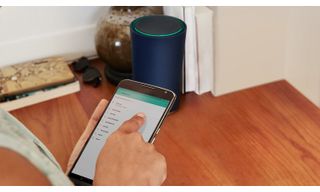Google OnHub Router Review
One of the easiest routers to install and set up, Google’s $200 OnHub may represent the future of home networking. For now, though, it has a high price tag, only one LAN port and limited features and configuration choices.
Why you can trust Tom's Guide

Google’s first router, the $200 OnHub, seemingly looks to the future, not only with an eye-catching design that’s unlike other routers, but also with the promise of greater capabilities to come.
The present, however, is less encouraging. While the OnHub delivers decent performance, particularly for congested home networks, its capabilities don’t quite live up to its price tag, and some users may be frustrated by Google-imposed limitations.
Editor's Note: Google has announced that the Google OnHub routers will reach end-of-life on Dec. 19, 2022. Firmware and security updates will end before then; after that date, the Google Home smartphone app will no longer be able to manage an OnHub router.
Design
Most routers are housed in boring rectangular boxes, but the OnHub looks like no other networking device. Shaped like a cone that’s been cut off at the bottom, it resembles the scale model of a modernist building. Available with a black or dark-blue cover, the OnHub has a brushed-aluminum base and measures 4.1 x 4.6 x 7.5 inches.
You can take the cover off, revealing a ribbed cylinder underneath that’s just as cool-looking. Either way, this is one router you won’t be ashamed of having out in the open.
One thing you won’t see is the OnHub’s antennas. Those live under the router’s skin in a circular array of 13 antennas. That’s right — at a time when top-tier routers have six or eight antennas, and most make do with just two or three, OnHub has six antennas each for its 2.4- and 5-GHz bands, as well as one for monitoring network congestion every 5 minutes. If any of OnHub’s wireless channels are overloaded, the system reapportions the flow to the underutilized channels — something no other router does.
The OnHub goes its own way on lights as well. Rather than looking like a Christmas tree with blinking red, green and yellow lights, OnHub features an LED ring at the top that throbs red when it’s starting up, and bluish green when it’s ready. In addition to its power plug, the OnHub has only one downstream gigabit LAN port — not the four LAN ports nearly every other router provides — and a WAN port that connects to your broadband modem.
Those without such LAN appliances as network-attached hard drives or printers won’t even notice the shortage of physical ports. For others, it will be a minor inconvenience, because you can always add a third-party networking switch to add four or more ports. The OnHub lacks an on-off switch, but has a recessed reset switch on the system’s back.
MORE: Best Routers
The OnHub is powered by a 1.4-Ghz Qualcomm IPQ8064 processor that’s based on the chipmaker’s Snapdragon 600 line of chips, putting the router on a par with a midrange tablet in terms of horsepower. The router comes with 1GB of RAM and 4GB of flash memory for storing its firmware. A big step forward is that when the OnHub starts up, only trusted software is allowed to run, lessening the chances of a hacker taking over the router.
The OnHub is certainly powerful, but the missing element is user-interfacing software. For instance, there’s a powered USB port, but at the moment, it doesn’t really do anything. At some point, it might be used for connecting a hard drive, printer or who knows what, but for now, I’ve been using it to power a USB LED light, turning OnHub into a desk lamp.
In addition to its LED ring, the top of the OnHub has something other routers don’t: a speaker. The speaker makes an annoying chirping sound when a new client attempts to connect, and that’s about it. But this speaker has lots of potential future uses — an in-house intercom, doorbell or audio player — even if those capabilities aren’t available yet.
Specs
Wi-Fi Spec: 802.11ac/dual Band
Number of Antennas/Removable: 13/No
Ports: 1 Gbps LAN, USB 3.0
Peak 802.11ac performance: 265.3 Mbps (at 5 feet)
Range: 160 feet
Size: 4.1 x 4.6 x 7.5 inches
Setup Software
Like everything else that involves Google, setting up the OnHub requires a Google account. In this case though, the company says it won’t monitor traffic flowing through the router in the same way it monitors search activity. You’ll need to download, install and use the Google On app (available for Android and iOS devices) to configure the OnHub; all told, figure on spending about 5 minutes to go from a sealed box to an operating router.

The mobile app turns the expected browser-based lists of setup options into vivid icons, although the software runs only in portrait mode on your tablet or phone. Forget about accessing the OnHub on a computer: there’s no setup software for either Mac or Windows.
The OnHub autodetects your Internet feed, connects to your ISP and generates a unique Wi-Fi network name (SSID) and user-access passcode. Still, for security reasons, it’s a good idea to quickly change these items from what the OnHub generated. The OnHub uses WPA2 wireless encryption; there’s no way to use the much weaker WEP standard — or some other type of encryption standard — instead.
When the OnHub is ready to use, the speaker delivers a booming tone, and the app says that “Everything is great” while showing who’s connected. There’s a network check that tests the router’s download and upload speeds as well as the LAN’s Wi-Fi efficiency to see how much of your broadband data is getting through to the client. On the downside, this monitor ignores the status of wired traffic.
Configuration
While the OnHub doesn’t allow you to adjust things such as transmission power, channel width or beacon interval, you can use IP version 6, which is more efficient (and which you’ll have to use one day anyhow as the world runs out of IPv4 addresses). OnHub works only as an 802.11ac router, although it’s compatible with 802.11a, b, g and n clients; it’s a little disappointing that you can’t select which 802.11 spec to broadcast with.
In addition to setting the system to automatically load firmware updates as they become available, you can adjust the brightness of the OnHub’s light ring and even turn it off. The router has a light sensor, but, like so many intriguing things about the OnHub, you can’t yet enable it.

The router connected with a variety of clients, including an iPad, an Android tablet and phone, and PCs and Macs. Like other midpriced routers, the OnHub can’t use a Radius server to authenticate clients. The router has a Network Address Translation (NAT) firewall but does without a stateful packet inspection (SPI) firewall to keep the bad guys out. It lacks the ability to create guest LANs with different access levels. These basic security settings are fine for most home users, though.
To get the most out of OnHub, you’ll need to designate someone in your household (or small office) as a manager, who can make changes but not reset the system. Only the person whose Google account was used to start up the router can reset it. While OnHub doesn’t have traditional quality-of-service software, it allows you to designate the priority device — say, a computer used for work — that gets first dibs on the data.
Performance
The dual-band OnHub features a peak theoretical throughput of 1.9 Gbps; 600 Mbps of that flow through its 2.4-GHz portion and 1.3 Gbps go through the 5-GHz section. The device uses a two-year-old Qualcomm QCA 9880 radio chip that allows three lanes of data traffic coming and going. Google’s router doesn’t support tri-band operations or MU-MIMO transmissions.
In real-world testing using Ixia’s ixChariot software, the OnHub was a mediocre performer at close range, with the ability to move 265.3 Mbps at a distance of 5 feet with a latency of 3.4 milliseconds. That’s well off the 308.4-Mbps average speed of six AC 1750 and AC1900 routers we recently tested. For example, TP-Link’s Archer C7 router delivered 304.4 Mbps with a latency of only 2 ms from the same distance.
The OnHub did better at long-distance transmissions, with 104.9 Mbps of bandwidth available at 140 feet, compared to 19.8 Mbps for the TP-Link Archer C7. Still, this was well behind the D-Link DIR-859’s 206.2 Mbps of throughput at 140 feet.
MORE: What is MU-MIMO?
Using a Toshiba Portege Z20t tablet, the OnHub was able to stay connected as far as 160 feet away from the OnHub in a suburban house with lots of walls — likely a benefit of all those antennas. This makes it a good router for filling a large home with data, assuming you can put the router roughly at the home’s center. The router easily passed our saturation test, in which we play an online movie on a tablet while watching a TV show on another system and listening to Internet radio, all while swapping data back and forth. The video and audio never stuttered or froze during the test.
One of the first routers to have Bluetooth built in, the OnHub supports the 802.15.4 wireless-data specification for home automation devices. Google says its router will work with ZigBee and Google Thread devices, which both use that same specification, but that feature wasn’t enabled in the version I looked at and Google hasn’t said when it will be.
Warranty
The OnHub two-year warranty is better than the single year of coverage that Amped Wireless and Linksys provide with their equipment. On the other hand, it can’t compare to the three-year warranty that’s included with Trendnet routers.
Bottom Line
Think of the OnHub as a Frankenstein-like router that pushes the technology in many areas while ignoring some of the conventions of modern networking. It has oodles of potential, with a huge antenna array and lots of unused hardware just waiting for software updates to enable them. The OnHub delivers mediocre performance close up, but the router really shines at long distances, which is as it should be.
At $200, OnHub is at the high end of the price spectrum, with the comparably priced $180 Amped Wireless RTA-1750 offering more set-up options and better throughput. The OnHub, though, puts the emphasis on quick setup, excellent apps and design. Plus, if Google comes through with software updates, the truly revolutionary nature of OnHub will someday shine through.
Sign up to get the BEST of Tom’s Guide direct to your inbox.
Upgrade your life with a daily dose of the biggest tech news, lifestyle hacks and our curated analysis. Be the first to know about cutting-edge gadgets and the hottest deals.
Brian Nadel is a freelance writer and editor who specializes in technology reporting and reviewing. He works out of the suburban New York City area and has covered topics from nuclear power plants and Wi-Fi routers to cars and tablets. The former editor-in-chief of Mobile Computing and Communications, Nadel is the recipient of the TransPacific Writing Award.

